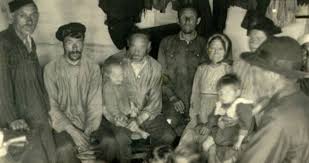In the 1930s, Joseph Stalin deported thousands of political opponents and prisoners to a remote gulag with so little food that it became known as “Cannibal Island.”
Nazino Island is a small, isolated piece of land in the middle of a Siberian river. Far from civilization, it’s a quiet place today, but it has a dark past. In May 1933, over 6,000 Soviet prisoners were sent to this island to build a settlement as part of Stalin’s network of gulags. Overcrowded and without food, shelter, or tools, the prisoners had to resort to extreme measures to survive.
Within three days, many began turning to cannibalism. Disease and starvation further reduced their numbers. By the time the Soviets shut down the island in July, only 2,000 prisoners were still alive.
Sending Soviet Prisoners To Nazino Island
The story of Nazino Island, or “Cannibal Island,” begins with Soviet dictator Joseph Stalin. After taking power following Vladimir Lenin’s death, Stalin expanded the network of Soviet gulags, labor camps for those deemed “undesirable” by his government.
These camps served two purposes: they removed “undesirables” from Soviet society and, in theory, created self-sustaining communities in remote areas of the Soviet Union. Nazino Island was one such remote location chosen for settlement. The people sent there included criminals, the unemployed, and innocent civilians arrested for not having proper paperwork, like a domestic passport.
In May 1933, the first boatload of Soviet prisoners arrived at Nazino Island. Although some two dozen had died during the voyage, about 3,000 survived and were left on the island with no food, tools, or shelter. Despite this, more boats kept arriving, and the island’s population soon grew to over 6,000. Crowded together, the prisoners turned to extreme measures to survive.
How Nazino Island Became Cannibal Island
Desperation quickly took hold among the prisoners on Nazino Island. They had nothing to eat. Almost 300 people didn’t survive the first frigid night due to a lack of shelter. The flour given to them by Soviet guards only worsened their situation. Without ovens or tools, some mixed it with dirty river water and died of dysentery, while others ate it raw and suffocated on the powder.
Within days, the prisoners resorted to cannibalism. “Every fourth or fifth day, some rye flour was brought to the island and distributed to the settlers, a few hundred grams each,” Soviet official Vasily Velichko wrote in a report. “People ran to the water and mixed it with the flour in their hats and ate it. Many just ate the flour as it was, and suffocated from breathing it in.”
“I only ate livers and hearts,” one surviving prisoner later told Soviet officials. “It was simple, just like shashlik… I picked those who were not quite living, but not yet quite dead. It was obvious they would die soon, so it was easier for them that way.”
Others were less compassionate. Female prisoners were tied to trees and had their body parts cut off. “They did that to me on the Island of Death,” one woman recounted after surviving the ordeal.
Another account describes how a woman, the lover of a camp guard named Kostia, was gruesomely murdered and eaten by prisoners. “People caught the girl, tied her to a poplar tree, cut off her breasts, her muscles, everything they could eat,” a witness recalled. “They were hungry… they had to eat. When Kostia came back, she was still alive, but she had lost too much blood.”
Many tried to flee Cannibal Island, but few succeeded. If their rafts didn’t sink, they were shot by guards. Even if they reached the opposite bank, they faced the harsh Siberian wilderness alone.
Of the more than 6,000 people sent to Nazino Island, only around 2,000 were alive when the island was evacuated in July. Survivors were sent to other labor camps, but few were in working condition, and most were physically and psychologically scarred.
The Bloody Legacy Of Cannibal Island
After Cannibal Island was evacuated, Soviet official Vasily Velichko interviewed dozens of people and sent his report to his superiors. “People began dying,” Velichko’s report read. “They burned to death alive while sleeping close to the fires. They died from exhaustion and cold.”
The horrors of Cannibal Island came to light in 1994. Today, locals travel to the island to lay flowers at the base of a wooden cross every year, honoring the memories of those who lost their lives there in 1933.
Almost one hundred years after the first boat of “settlers” arrived, Nazino Island seems like a quiet place. Aside from the wooden cross, there’s no hint of the horrors that occurred on its shores.
Now that you’ve read about Cannibal Island, learn 21 astounding Joseph Stalin facts that even history buffs don’t know. Then read about Issei Sagawa, the killer cannibal who is walking free.
